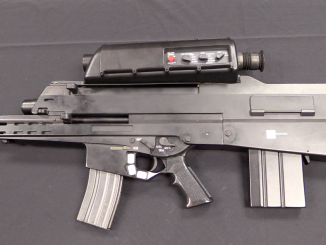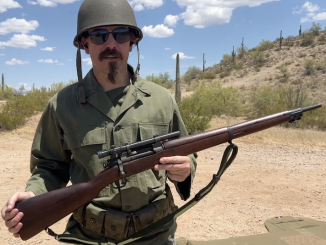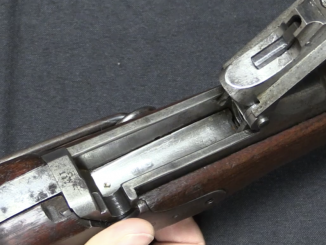When I was looking through the catalog for this upcoming Rock Island auction, I noticed that there were a lot of early-type Colt automatic pistols listed. I looked a bit closer, and noticed that there was, in fact, one of almost every major developmental variety. Well, that sounded like a recipe for a big overview video! So here I present the developmental history of the 1911:
The guns included in this video are:
Model 1900 Sight Safety
Model 1900 converted to 1902 Sporting
Model 1902 Sporting
Model 1902 Military
Model 1903 Pocket Hammer
Model 1905
Savage 1907
Model 1911
Model 1911/1924 Transitional
Model 1911A1




Really nice video, Ian!
Now we have at hand the best quick audiovisual reference source about the historical evolution of the 1911. Thanks!
Personal opinion: I consider the 1911A1 to be the best and most reliable combat sidearm ever developed. Before and while in the Marines I carried one made by Remmington Typewriter Company. It had a Clark Combat Conversion (Jim Clark of Shreveport, LA http://www.bullseyepistol.com/clark.htm) with a Douglas barrel and never once malfunctioned while ingesting many thousands of handloads and issue rounds. In four gunfights it was used in it was like hitting the opponent with a Freightliner. I also use a 1911A1 Clark conversion with a scope and have killed several deer with it, the longest shot being at 87 measured yards, as well as many hogs and other game. Col. Charles Askins preferred the 1911A1 over the .357 S&W carried by Bill Jordan and other Border Patrol agents. He is actually the one who coined the phrase about using a .45 because they did not make one in .46 cal. The main modification he made was to cut out the front of the trigger guard for faster trigger access. I have often jacked the MV up to 900+ fps but it is not pleasant to shoot at that level.
When did external extractors begin to appear on 1911s? Very well done video by the way.
Not sure offhand – they were a third-party commercial modification on the 1911, although some foreign military copies (like the Star) used them much earlier.
Inside extractors can not offer certain advantages over the outsiders and Mr J.Browning also stated that fact within one patent text of Colt related pistols. It simply lowers the manufacturing costs. But its presence with a live round stuck within the chamber, would be real nightmare since, extractor offers no place to catch and disengage the hook from the case rim to go to take down safely.
Quite a nice video.
One question – I have this notion that the original 1911 has an obscure issue with unintended discharges when dropped at exactly the wrong angle, and that the 1911A1 somehow fixed that. Am I just confused?
(Both pistols are drop safe in the general case, right? The issue only arose if the gun was dropped at a very particular angle?)
I don’t know of a special angle at which the 1911 is vulnerable in a drop test – I consider them as drop-safe as anything single action.
If you drop a 1911 muzzle straight down on a hard surface, it can discharge due to the inertia of the firing pin, especially with a high seated or easily-initiated primer.
That’s why the Series 80 firing pin safety was added.
it was not the first firing pin safety for the 1911. That was the Swartz safety, installed on commercial colts in the late 30s, and in some 1911s now (Kimber & S&W, I think; most other 1911 clones use a Series 80 or Series-80-like firing pin safety; low-end imports generally lack this feature):
https://www.youtube.com/watch?v=DQcT8yooEmE
There is no difference between the pre-1926 1911 and the post-26 1911A1 on this. All USGI 1911s lack a firing pin safety, although some Swartz commercials were lend-leased.
It is only an issue if it is dropped such that the muzzle hits the ground at a 90 degree angle from a height, and the floor is hard. I have an early Kimber that has no firing pin safety, and have never had the slightest concern about it.
Used to have a series 80 and it was more small parts to lose or get gunked up while detracting from the trigger pull. Don’t know anything about the Swartz safety. Apparently using a light weight titanium firing pin is another fix
Seems it is of more interest to lawyers than anyone else. An amusing take on it was on the video tapes Col Cooper made in the 1980’s: he said that it had happened on his range, but so what? Bullet went into the ground, no one is hurt, pick up the gun and shoot.
firing pin safeties on hammer pistols are made to prevent accidental discharges at muzzle down drops which, in fact mostly useless since the bullet would sink into the ground or, if ricochets, seldom rises up to one foot from the ground which can not cause a lethal wound generally. Real danger comes with muzzle up drops in which these kind of passive safeties will not work if the trigger to work through inertia as disengaging firing pin block and sear connect with a cocked hammer. Colt 1911 grip safety is supposed to prevent such an inertial movement of trigger bar if a muzzle up drop occurs, but the gun may drop just on the spur of grip safety causing it to go off, or at a flat surface again actuating it. If that surface is a step, straight back of mainspring housing of 1911 would be a disadvantage and curved back of 1911A1 would be an advantage to keep the grip safety away from that step.
Lovely guns, that finish is beautiful on the model which retains it, very informative video. Did Browning invent the dropping version, the tilting one or both out of interest. The dropping version seems to have 3 lugs in .38acp were as the 1911 .45acps have two generally I think. The tilting version of the dropping barrel was probably cheaper, I wonder it the the dropping one was any more accurate… In relation to fixed barreled pistols supposedly being, the bullet might get a wee flip at the end in the tilting version, were as a dropping version would almost counter act the muzzle flip “if either have any influence on the bullet, which I assume they do if fixed barrels are deemed to be more accurate fundamentally” Was the .38acp quite powerful, or maybe they just didn’t know they could get away with two lugs like in the .45acp if that was more powerful. Maybe they kept three lugs, when they went to the tilty version but it didn’t fit correctly and caused the cracks etc hence why they lost the third one i.e. To make it function with the tilting method, trial and error etc.
I have read the .38acp has a maximum 36,000psi chamber pressure… Turns out it’s more or less the .38 Super which I have heard of in those “race” guns… That’s more 9mm Luger than .45acp pressure, does chamber pressure equate to bolt thrust anyone out of general interest?
There are formulas for this in design books, but it’s not rocket surgery. (Chamber pressure in psi) X (area of the cartridge head) yields the direct force on the bolt face in inch-pounds. There are some details to how you figure this area but this is close enough for horseshoes and hand grenades.
Please do not ever fire .38 super in one of these old .38 ACP firearms. Not safe!
The dropping barrel isn’t quite the same as a tilting barrel in relation to the angle the muzzle ends up in, a dropping barrel keeps the barrel level on a horizontal plane. A tilting barrel tips the muzzle up vertically, in relation to the position of the chamber. Might effect accuracy, the 1913 Webley had a form of dropping barrel I wonder if it shot low, maybe the bullet isn’t effected not sure – But you would think so, if fixed barrels have any benefit in this regard.
Although maybe the bullet has left before it tilts at all or indeed drops… Perhaps it relates to general wobble – side to side etc, in regards fixed barrel accuracy – even with barrels which move straight back like the M9, maybe it wiggles somewhat. Anyway interesting stuff, nice guns.
Excellent video, Ian. Professionally produced and narrated. This one will be a well-used reference for years to come.
Two thing: I find it interesting that the rounded grip profile was in, then out, and is now becoming more popular; also, the ‘drop angle’ mentioned earlier— was something along that line not the reason for the Series 80 trigger?
Ian the vulnerabilIty to firing in a drop test of a 1911 happens when the gun is carried with a round chambered safety off and hammer on the half cocked position. The only way to safely carry a 1911 pistol with a round in the chamber is “cocked and locked”. Many people don’t like the look of a cocked and locked pistol even though it is the only safe way to carry a 1911.
The military considered condition 3 (loaded magazine, no round chambered) to be the only safe way to carry the 1911 and said so in every edition of the 1911 manual I have read. The whole cocked and locked thing was from LEO and certain individuals who pushed gunslinging.
The thumb saftey was added by the request of the US Army so that cavalry troopers could temporarily safe the weapon with one hand prior to returning it to proper condition 3 for carry in their holster.
Ian,
When you were examining the pistols did you notice when Colt stopped using the bronze firing pin?
I noticed that the 1900 sight safety did not have it. I saw it on the 1902 sporting, and the 1903 pocket hammer i have had experience with had it (made in 1906 as i recall). Couldn’t tell on the other models in the video. It would be interesting to know when they finally concluded that might have been a bad idea.
Also, at least with the 1902 and 1903, the firing pin is simply retained with a cross pin and not the later plate system. The rear portion of the bronze firing pic has a cut out that interacts with the pin traveling through the slide. Anyway, nice video, great to see almost the whole “family” together!
Sorry – I didn’t think to look.
Very nice show indeed. It reflects on glory days of Colt company. I did not know that very early guns in full size lineup were in .38 ACP, so this adds to my knowledge. Thanks!